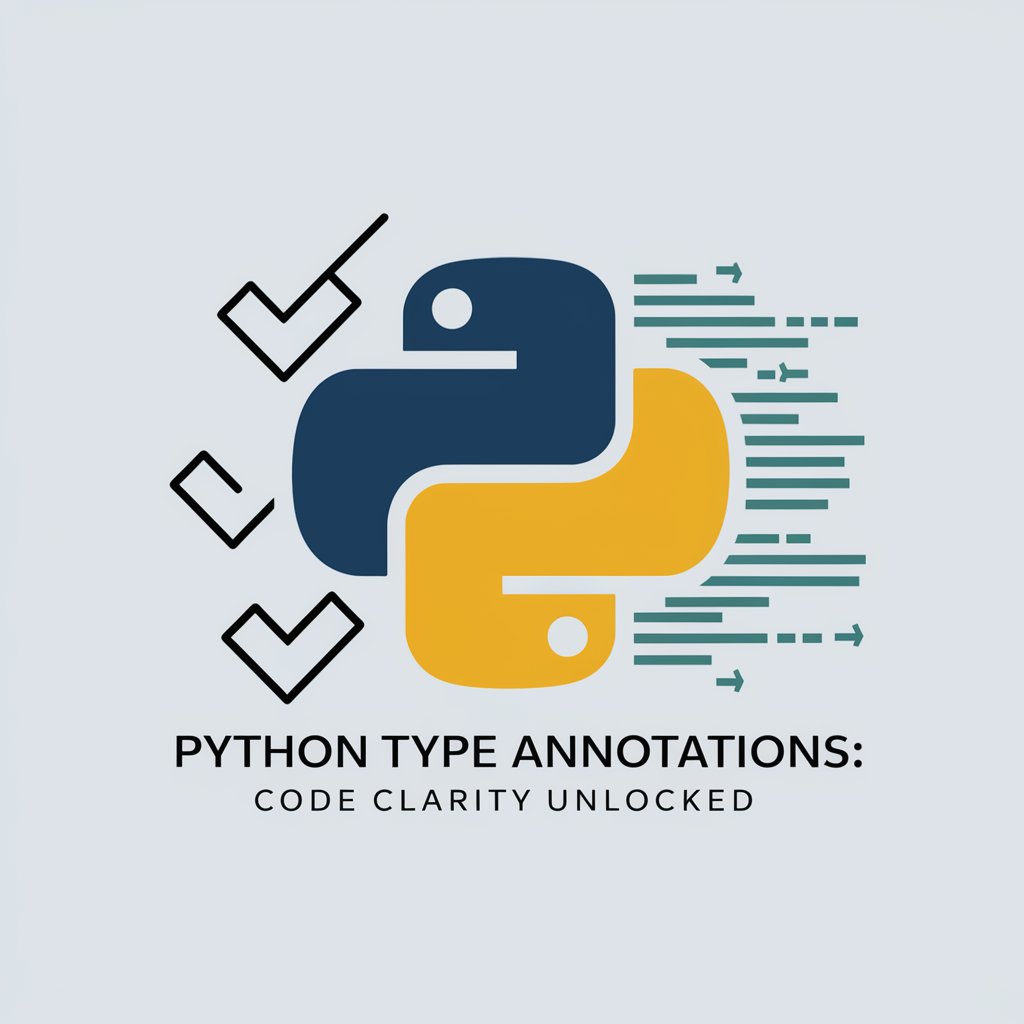
Python Type Annotations: Code Clarity Unlocked - Python Type Enhancements

Welcome! Let's enhance your Python code clarity with type annotations.
Clarify Python code with AI-powered annotations
Explore the benefits of using type annotations in Python...
Learn how Python's typing module can transform your coding practices...
Discover how to integrate type annotations seamlessly into your Python projects...
Understand the advanced type annotations like Union, Optional, and Callable with practical examples...
Get Embed Code
Introduction to Python Type Annotations: Code Clarity Unlocked
Python Type Annotations are a significant addition to Python, introduced in PEP 484, that enable developers to explicitly indicate the data types of variables, function parameters, and return types. The primary design purpose of type annotations is to facilitate code readability and to help catch certain types of errors early in the development process through static type checking. Unlike Python's dynamic typing, which determines types at runtime, type annotations allow for type checking at compile time, offering a form of documentation that can be used by static type checkers, IDEs, and linters. For example, a function without type annotations might look like this: ``` def add(a, b): return a + b ``` With type annotations, it becomes clearer what types of arguments are expected and what type is returned: ``` def add(a: int, b: int) -> int: return a + b ``` This explicitness not only improves code clarity for the developer but also aids in preventing bugs related to type mismatches. Powered by ChatGPT-4o。

Main Functions of Python Type Annotations
Enhancing Readability and Maintainability
Example
def calculate_distance(point_a: Tuple[int, int], point_b: Tuple[int, int]) -> float:
Scenario
In a geographic information system (GIS) application, developers can use type annotations to clarify that the function expects tuples of integers for coordinates and returns a floating-point number representing the distance. This makes the code easier to understand and maintain, especially for new developers joining the project.
Facilitating Static Type Checking
Example
from typing import List def sort_items(items: List[int]) -> List[int]:
Scenario
In a data processing application, using type annotations helps to ensure that the function 'sort_items' receives a list of integers. Static type checkers can catch errors where, for example, a list of strings is passed, preventing runtime errors and improving code reliability.
Supporting Advanced Type Constructs
Example
from typing import Optional, Union def get_user_input(prompt: str) -> Optional[Union[int, str]]:
Scenario
In a command-line application, this function demonstrates the use of complex types like `Optional` and `Union` to indicate that the function can return `None`, an integer, or a string, providing flexibility in handling user input while still maintaining type safety.
Ideal Users of Python Type Annotations
Software Developers
Developers working in Python, especially in large or complex projects, can greatly benefit from type annotations by making the code more readable, easier to understand, and safer from type-related bugs. It's particularly beneficial for teams to maintain a consistent codebase and for individual developers aiming to improve their coding practices.
Project Managers and Team Leads
Managers and team leads can enforce the use of type annotations in their projects to reduce the likelihood of bugs and to facilitate smoother onboarding of new team members. It helps in setting a higher standard of code quality and in ensuring that the codebase remains maintainable over time.
Educators and Trainers
Educators teaching Python programming can incorporate type annotations into their curriculum to introduce students to best practices in software development early on. It helps students understand the importance of type safety and code documentation, preparing them for industry standards.

Utilizing Python Type Annotations for Enhanced Code Clarity
Start your journey
Begin by exploring the benefits of type annotations with a hands-on trial at platforms offering Python coding environments, such as yeschat.ai, which provides a seamless experience without the need for sign-ups or subscriptions.
Understand the basics
Familiarize yourself with the `typing` module in Python. Learn the syntax for basic types like `int`, `str`, `float`, and more complex structures like `List[T]`, `Dict[K, V]`, and `Optional[T]`.
Apply in functions
Start annotating your function definitions. Specify types for all parameters and the return value using the syntax `def function_name(param: Type) -> ReturnType:`. This clarifies the expected input and output for each function.
Leverage advanced types
Explore advanced type annotations such as `Union[T1, T2]`, `Callable`, and `TypeVar` for more complex scenarios. These types allow for more flexible and powerful type hints.
Use a type checker
Integrate a static type checker like `mypy` or `pyright` into your development process. Regularly run the type checker to identify and resolve type mismatches, improving code reliability.
Try other advanced and practical GPTs
Calibrate Foods Coach
Smart Eating, Healthier Living

Lesson Planner Pro
AI-Powered Custom Lesson Planning

Astronomy and Astrology Guide
Bridging Cosmos and Comfort with AI

GPT Builder Hero
Empower your projects with AI customization.

Advocacy Ally
Empowering Nonprofits with AI-Powered Advocacy

Creature Creator
Craft Imaginary Creatures with AI

Voyage Planner Pro
Craft Your Journey with AI

Imagination Visualizer
Visualize Your Imagination with AI

Cultural Interpreter
Navigating cultures with AI-powered insights.

Language Flash
AI-Powered Language Mastery

COSTUME DESIGN
Bringing Costume Visions to Life with AI

World History Bot
Explore History with AI-Powered Precision

Frequently Asked Questions on Python Type Annotations
What are Python Type Annotations?
Python Type Annotations are a syntax introduced in Python 3.5 that allow for explicit type hints in the code. These hints are not enforced at runtime but are used by static type checkers, IDEs, and linters to identify potential bugs.
How do type annotations improve code clarity?
Type annotations clarify the kinds of values functions expect and return, making the code more readable and self-documenting. They assist developers in understanding the codebase faster and reduce the risk of type-related bugs.
Can type annotations affect runtime performance?
No, type annotations are ignored at runtime and do not affect the performance of Python programs. They are purely for development purposes, providing a richer experience in code analysis and assistance.
Are type annotations mandatory in Python?
Type annotations are optional in Python, embracing its dynamic typing nature. However, they are highly recommended for large codebases, libraries, and projects where clarity and maintainability are crucial.
How do I handle dynamic types in annotations?
For dynamic types, Python offers the `Any` type from the `typing` module, allowing for any value. Advanced constructs like `Union`, `TypeVar`, and `Callable` can also describe more complex dynamic behavior.